- Calendar
- Online Ticket Sales
- Access
- JA
- EN
Blown Glass: Enchanting Forms, Miraculous Skills
April 22 to June 25, 2023
*Download the list of changes in works on display
*There will be an exhibition change during the course of exhibition.
*Photography permitted only for works with PHOTO OK mark in this exhibition.
The list of changes in worksPDF
*The order of chapters may change at the exhibition venue.
Section I: The Natural Beauty of Curves—Blown Glass from Ancient Rome
Glassblowing is thought to have originated in the eastern Mediterranean region under the rule of the Roman Empire, in about the middle of the first century BCE. Glassblowing, in which a vessel is formed a great speed, before the glass cools, was a revolutionary technique that made possible completing a single vessel in a short period of time. Early blown glass works include sharp shapes formed by mold blowing as well as the use of colors that create effects resembling stone or metal vessels. Over time, however, soft, relaxed forms made without the use of molds became increasingly prevalent. Forms with the natural beauty of curves, formed through the powers of gravity and centrifugal force, and generous, carefree decorations are among the fascinations of ancient Roman blown glass.
This section introduces a great variety of blown-glass works from the Roman period. Particularly noteworthy are works with unusual forms, known as double-bodied and quadripartite cosmetic tubes. Here, based on the results of the most recent research, we delve into that technique’s secrets.
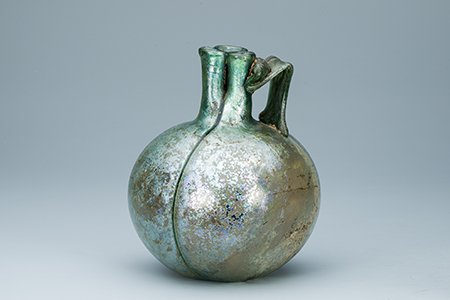
Eastern Mediterranean, 2nd-3rd century
Okayama Orient Museum
【To be shown over an entire period】
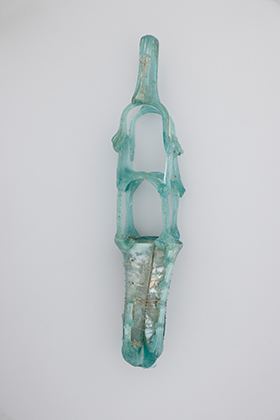
Eastern Mediterranean, 4th-5th century
Toyama Memorial Museum
【To be shown over an entire period】
Section II: The Hot Work Magic—European Blown Glass
“Hot work” refers to forming and manipulating glass while it is hot, having been melted in a furnace and it reached a peak in Venice, Italy, in the fifteenth through the seventeenth centuries. Venetian blown glass, with the pure beauty of nearly colorless, transparent glass called cristallo (“crystal”), its graceful, elegant forms, and the complex, delicate, three-dimensional decorations that hot work made possible, became the dominant luxury product in the European market for glass. Particularly filigree glass, which they developed in the sixteenth century, is the fruit of the inventiveness and creativity of Venetian glassblowers who took hot work to a new level. Venetian blown glass was copied in many other places and a great many works created in the Venetian style.
This section presents masterworks of Venetian and Venetian-style blown glass from the sixteenth through the nineteenth centuries as well as works by four contemporary glass artists who carry on the techniques and the beauty of Venetian glass. Please enjoy the explanations of these works from the point of view of their creators, provided in a collaboration between the museum and these glass artists.

Italy, 16th-17th century
Suntory Museum of Art
【To be shown over an entire period】
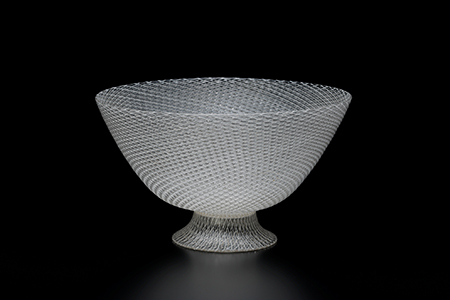
Italy, 16th-17th century
Suntory Museum of Art
【To be shown over an entire period】
Section III: Limitations Inspire Artistic Effects—East Asian Blown Glass
Under the stimulus of those works from areas to the west, the production of blown glass in East Asia began in the fifth century, during China’s Northern Wei period (386-534). Prior to the modern period, East Asian blown glass was generally smaller, thinner walled, had little hot-work decoration, and was simply made. The lack of the pontil, a tool needed for forming the vessel’s mouth, and of full-scale annealing, which is essential for creating large, thick-bodied, works, imposed limitations on forming blown glass in East Asia. However, those technical restrictions, far from being a negative factor, brought about the distinctive artistry of East Asian blown glass, with the simple charm and delicate beauty that distinguish it from glass created in Western regions.
This section introduces East Asian blown glass from roughly the twelfth through the nineteenth centuries through works that have been handed down in Japan. This section also includes the results of technical research conducted on the Indigo-blue Sake Ewer in our collection in an opportunity to enjoy the techniques and beauty of blown glass unique to East Asia.
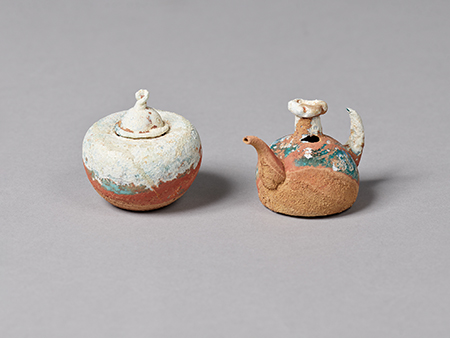
Said to be from artifacts excavated near the Konpon Nyohodo on Hieizan, Shiga prefecture
Probably Song period China or Japan
12th century, Nara National Museum
(Picture provided by Nara National Museum)
【To be shown over an entire period】
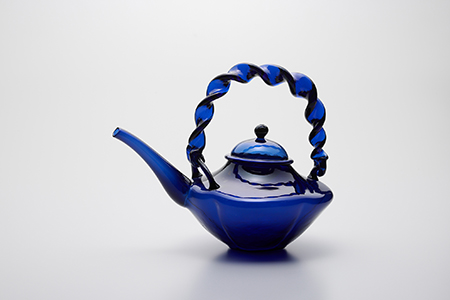
Japan, 18th century
Suntory Museum of Art
【To be shown over an entire period】
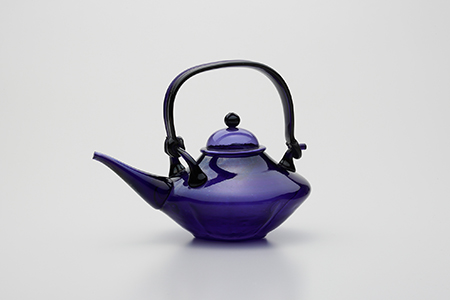
Japan, 18th–19th century
Kuwana City Museum, Gift of TANAKA Ichiro
【To be shown over an entire period】
Section IV: Hand Work from the Modern Period to Today—Modern Japanese Blown Glass
As the Meiji era (1868-1912) began, Western production styles, tools and methods of glass blowing were introduced. The Shinagawa Glass Works, which was managed by the government from 1876 and 1884, played a critical role in the early introduction of Western techniques. While the glass works was under government management, trainees learned glassblowing and other Western techniques for making glass from expert engineers invited to Japan from Europe. Those trainees went on to found glassworks throughout the country, contributing to the advance of glass production in Japan.
This section presents blown glass created in Japan from the Meiji era on. The diverse varieties of frozen dessert cups, produced from around the 1890s to the 1930s, give a sense of the zenith of blown glass production, prior to its mechanization. The exhibits include works by three companies that continue to blow glass by hand today and introduces the distinctive efforts of each company as they address the future of blown glass as an industry.
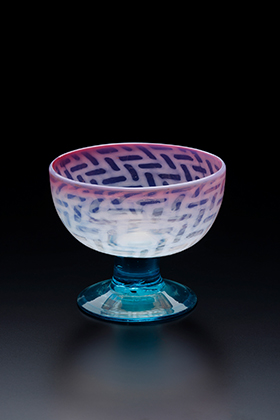
Japan, 20th century
Private Collection
【To be shown over an entire period】
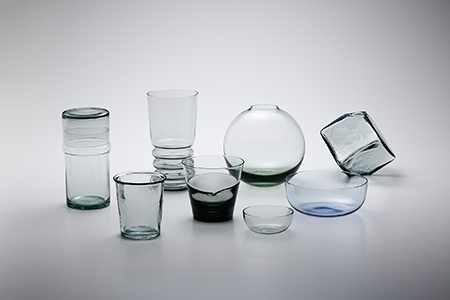
SUGAHARA GLASSWORKS
【To be shown over an entire period】
Section V: Expanding Possibilities—Blown Glass as Contemporary Art
This section introduces the work of four up-and-coming young glass artists who are using glassblowing as their means of artistic expression. The work of YOKOYAMA Shohei and KOBAYASHI Chisa makes effective use of the dynamic movements possible only with hot, molten glass, capturing a shape born in a moment born in the act of expanding and stretching the glass. FUJIKAKE Sachi and TAKEOKA Kensuke, however, use hot work to distort parts prepared in advance in kiln work (melting the glass in an electric kiln and shaping and processing it) to create works of glass with a new materiality.
These works make us wonder, “Are these really blown glass?” Through them, we hope you will sense even greater possibilities in blown glass.

KOBAYASHI Chisa, 2022
Artist’s Collection
【To be shown over an entire period】
*Unauthorized reproduction or use of texts or images from this site is prohibited.
2025 January
- Exhibition
- Closed
- Tea Ceremony
- Mon
- Tue
- Wed
- Thu
- Fri
- Sat
- Sun
- 1
- 2
- 3
- 4
- 5
- 6
- 7
- 8
- 9
- 10
- 11
- 12
- 13
- 14
- 15
- 16
- 17
- 18
- 19
- 20
- 21
- 22
- 23
- 24
- 25
- 26
- 27
- 28
- 29
- 30
- 31
2025 February
- Exhibition
- Closed
- Tea Ceremony
- Mon
- Tue
- Wed
- Thu
- Fri
- Sat
- Sun
- 1
- 2
- 3
- 4
- 5
- 6
- 7
- 8
- 9
- 10
- 11
- 12
- 13
- 14
- 15
- 16
- 17
- 18
- 19
- 20
- 21
- 22
- 23
- 24
- 25
- 26
- 27
- 28
2025 March
- Exhibition
- Closed
- Tea Ceremony
- Mon
- Tue
- Wed
- Thu
- Fri
- Sat
- Sun
- 1
- 2
- 3
- 4
- 5
- 6
- 7
- 8
- 9
- 10
- 11
- 12
- 13
- 14
- 15
- 16
- 17
- 18
- 19
- 20
- 21
- 22
- 23
- 24
- 25
- 26
- 27
- 28
- 29
- 30
- 31
2025 April
- Exhibition
- Closed
- Tea Ceremony
- Mon
- Tue
- Wed
- Thu
- Fri
- Sat
- Sun
- 1
- 2
- 3
- 4
- 5
- 6
- 7
- 8
- 9
- 10
- 11
- 12
- 13
- 14
- 15
- 16
- 17
- 18
- 19
- 20
- 21
- 22
- 23
- 24
- 25
- 26
- 27
- 28
- 29
- 30
2025 May
- Exhibition
- Closed
- Tea Ceremony
- Mon
- Tue
- Wed
- Thu
- Fri
- Sat
- Sun
- 1
- 2
- 3
- 4
- 5
- 6
- 7
- 8
- 9
- 10
- 11
- 12
- 13
- 14
- 15
- 16
- 17
- 18
- 19
- 20
- 21
- 22
- 23
- 24
- 25
- 26
- 27
- 28
- 29
- 30
- 31
2025 June
- Exhibition
- Closed
- Tea Ceremony
- Mon
- Tue
- Wed
- Thu
- Fri
- Sat
- Sun
- 1
- 2
- 3
- 4
- 5
- 6
- 7
- 8
- 9
- 10
- 11
- 12
- 13
- 14
- 15
- 16
- 17
- 18
- 19
- 20
- 21
- 22
- 23
- 24
- 25
- 26
- 27
- 28
- 29
- 30
2025 July
- Exhibition
- Closed
- Tea Ceremony
- Mon
- Tue
- Wed
- Thu
- Fri
- Sat
- Sun
- 1
- 2
- 3
- 4
- 5
- 6
- 7
- 8
- 9
- 10
- 11
- 12
- 13
- 14
- 15
- 16
- 17
- 18
- 19
- 20
- 21
- 22
- 23
- 24
- 25
- 26
- 27
- 28
- 29
- 30
- 31
2025 August
- Exhibition
- Closed
- Tea Ceremony
- Mon
- Tue
- Wed
- Thu
- Fri
- Sat
- Sun
- 1
- 2
- 3
- 4
- 5
- 6
- 7
- 8
- 9
- 10
- 11
- 12
- 13
- 14
- 15
- 16
- 17
- 18
- 19
- 20
- 21
- 22
- 23
- 24
- 25
- 26
- 27
- 28
- 29
- 30
- 31
2025 September
- Exhibition
- Closed
- Tea Ceremony
- Mon
- Tue
- Wed
- Thu
- Fri
- Sat
- Sun
- 1
- 2
- 3
- 4
- 5
- 6
- 7
- 8
- 9
- 10
- 11
- 12
- 13
- 14
- 15
- 16
- 17
- 18
- 19
- 20
- 21
- 22
- 23
- 24
- 25
- 26
- 27
- 28
- 29
- 30
2025 October
- Exhibition
- Closed
- Tea Ceremony
- Mon
- Tue
- Wed
- Thu
- Fri
- Sat
- Sun
- 1
- 2
- 3
- 4
- 5
- 6
- 7
- 8
- 9
- 10
- 11
- 12
- 13
- 14
- 15
- 16
- 17
- 18
- 19
- 20
- 21
- 22
- 23
- 24
- 25
- 26
- 27
- 28
- 29
- 30
- 31
2025 November
- Exhibition
- Closed
- Tea Ceremony
- Mon
- Tue
- Wed
- Thu
- Fri
- Sat
- Sun
- 1
- 2
- 3
- 4
- 5
- 6
- 7
- 8
- 9
- 10
- 11
- 12
- 13
- 14
- 15
- 16
- 17
- 18
- 19
- 20
- 21
- 22
- 23
- 24
- 25
- 26
- 27
- 28
- 29
- 30
2025 December
- Exhibition
- Closed
- Tea Ceremony
- Mon
- Tue
- Wed
- Thu
- Fri
- Sat
- Sun
- 1
- 2
- 3
- 4
- 5
- 6
- 7
- 8
- 9
- 10
- 11
- 12
- 13
- 14
- 15
- 16
- 17
- 18
- 19
- 20
- 21
- 22
- 23
- 24
- 25
- 26
- 27
- 28
- 29
- 30
- 31
2026 January
- Exhibition
- Closed
- Tea Ceremony
- Mon
- Tue
- Wed
- Thu
- Fri
- Sat
- Sun
- 1
- 2
- 3
- 4
- 5
- 6
- 7
- 8
- 9
- 10
- 11
- 12
- 13
- 14
- 15
- 16
- 17
- 18
- 19
- 20
- 21
- 22
- 23
- 24
- 25
- 26
- 27
- 28
- 29
- 30
- 31
2026 February
- Exhibition
- Closed
- Mon
- Tue
- Wed
- Thu
- Fri
- Sat
- Sun
- 1
- 2
- 3
- 4
- 5
- 6
- 7
- 8
- 9
- 10
- 11
- 12
- 13
- 14
- 15
- 16
- 17
- 18
- 19
- 20
- 21
- 22
- 23
- 24
- 25
- 26
- 27
- 28
2026 March
- Exhibition
- Closed
- Mon
- Tue
- Wed
- Thu
- Fri
- Sat
- Sun
- 1
- 2
- 3
- 4
- 5
- 6
- 7
- 8
- 9
- 10
- 11
- 12
- 13
- 14
- 15
- 16
- 17
- 18
- 19
- 20
- 21
- 22
- 23
- 24
- 25
- 26
- 27
- 28
- 29
- 30
- 31
2026 April
- Exhibition
- Closed
- Mon
- Tue
- Wed
- Thu
- Fri
- Sat
- Sun
- 1
- 2
- 3
- 4
- 5
- 6
- 7
- 8
- 9
- 10
- 11
- 12
- 13
- 14
- 15
- 16
- 17
- 18
- 19
- 20
- 21
- 22
- 23
- 24
- 25
- 26
- 27
- 28
- 29
- 30
2026 May
- Exhibition
- Closed
- Mon
- Tue
- Wed
- Thu
- Fri
- Sat
- Sun
- 1
- 2
- 3
- 4
- 5
- 6
- 7
- 8
- 9
- 10
- 11
- 12
- 13
- 14
- 15
- 16
- 17
- 18
- 19
- 20
- 21
- 22
- 23
- 24
- 25
- 26
- 27
- 28
- 29
- 30
- 31
2026 June
- Exhibition
- Closed
- Mon
- Tue
- Wed
- Thu
- Fri
- Sat
- Sun
- 1
- 2
- 3
- 4
- 5
- 6
- 7
- 8
- 9
- 10
- 11
- 12
- 13
- 14
- 15
- 16
- 17
- 18
- 19
- 20
- 21
- 22
- 23
- 24
- 25
- 26
- 27
- 28
- 29
- 30
2026 July
- Exhibition
- Closed
- Mon
- Tue
- Wed
- Thu
- Fri
- Sat
- Sun
- 1
- 2
- 3
- 4
- 5
- 6
- 7
- 8
- 9
- 10
- 11
- 12
- 13
- 14
- 15
- 16
- 17
- 18
- 19
- 20
- 21
- 22
- 23
- 24
- 25
- 26
- 27
- 28
- 29
- 30
- 31
2026 August
- Exhibition
- Closed
- Mon
- Tue
- Wed
- Thu
- Fri
- Sat
- Sun
- 1
- 2
- 3
- 4
- 5
- 6
- 7
- 8
- 9
- 10
- 11
- 12
- 13
- 14
- 15
- 16
- 17
- 18
- 19
- 20
- 21
- 22
- 23
- 24
- 25
- 26
- 27
- 28
- 29
- 30
- 31
2026 September
- Exhibition
- Closed
- Mon
- Tue
- Wed
- Thu
- Fri
- Sat
- Sun
- 1
- 2
- 3
- 4
- 5
- 6
- 7
- 8
- 9
- 10
- 11
- 12
- 13
- 14
- 15
- 16
- 17
- 18
- 19
- 20
- 21
- 22
- 23
- 24
- 25
- 26
- 27
- 28
- 29
- 30
2026 October
- Exhibition
- Closed
- Mon
- Tue
- Wed
- Thu
- Fri
- Sat
- Sun
- 1
- 2
- 3
- 4
- 5
- 6
- 7
- 8
- 9
- 10
- 11
- 12
- 13
- 14
- 15
- 16
- 17
- 18
- 19
- 20
- 21
- 22
- 23
- 24
- 25
- 26
- 27
- 28
- 29
- 30
- 31
2026 November
- Exhibition
- Closed
- Mon
- Tue
- Wed
- Thu
- Fri
- Sat
- Sun
- 1
- 2
- 3
- 4
- 5
- 6
- 7
- 8
- 9
- 10
- 11
- 12
- 13
- 14
- 15
- 16
- 17
- 18
- 19
- 20
- 21
- 22
- 23
- 24
- 25
- 26
- 27
- 28
- 29
- 30
2026 December
- Exhibition
- Closed
- Mon
- Tue
- Wed
- Thu
- Fri
- Sat
- Sun
- 1
- 2
- 3
- 4
- 5
- 6
- 7
- 8
- 9
- 10
- 11
- 12
- 13
- 14
- 15
- 16
- 17
- 18
- 19
- 20
- 21
- 22
- 23
- 24
- 25
- 26
- 27
- 28
- 29
- 30
- 31
